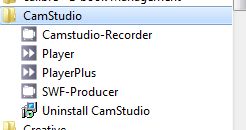I think that most people just assume that everyone understands the difference between RAM and storage space, dual core and quad core, etc. If that was the case, why does everyone still call the desktop computer a CPU? Here’s a rundown of the terms that are used in a typical computer ad. It’s not difficult once you get past the buzzwords. Here is a typical ad:

This isn’t even the full list of specs. I’ll run through the important ones here. If there is something that still confuses you, ask me in a comment.
This is a notebook, or laptop. Most people these days seem to prefer laptops as opposed to desktops. Mobility is the key here. A huge section of people use mobile phones to connect to the Internet, too. The size you buy is up to you but a 14″ is great for moving around school or work, while a 15.6″ or 17″ can be used as a ‘desktop replacement’.
A netbook is much smaller, usually with a 10″ screen. These are great for taking everywhere you go. I’ll stick to more conventional computers here instead of confusing the issue more with the new pads. The terms are pretty much the same, regardless of the style you buy. Here are some of the terms explained:
1. AMD Quad Core A6-3400DM Processor – This is the brain of the computer, the part that gets really hot and looks huge in a desktop but is really only the size of a Triscuit, and about the same thickness. The two big names are AMD and Intel. You will recognize Intel, I think. Each company maintains a well documented site that will allow you to search out the age of the processor you are looking at. The price you pay for your computer is partially dictated by the price of the processor. This isn’t always the case, however, since Intel’s new processors are even cheaper than the older ones and much, much faster. For most people, the standard dual or quad core is fine. Two heads (dual core) is better than one and four heads (quad core) is even better.
2. 4GB Shared Dual Channel DDR3 at 1333MHZ, 2 DIMM – This is called RAM (random access memory). It’s what the computer uses to keep track of things while it’s running. These days, 2 gigabytes is an absolute bare minimum, 4 to 8 gigabytes is much more common. The more RAM, the more things your computer will be able to think about. You can run two, three, four or more programs at the same time. Less RAM means your computer can only think of one thing…very slowly. Adding RAM to an old computer will do wonders for its speed. All you really need to know here is how many gigs of RAM you get with the computer and, potentially, how much more you can add. This is using 2 sticks (2 dimms). Most laptops only have two slots so you’d have to swap out the memory completely as opposed to adding another stick. 4 gigs is my minimum at this point. All RAM these days is Dual Channel, that’s just there to confuse you or to make it sound better.
3. 320 GB 7200RPM SATA Hard Drive – This is the storage NOT memory. The hard drive is where you store your files, music, videos, etc. The bigger the hard drive, the more you can store. This particular drive is an OK size and a GOOD speed. Most laptop drives are only 5400 RPM. This one is 7200 which means that it will be able to feed out stuff faster. However, it will also use up more power and create more heat, two things that will affect your battery life. I’m fine with 5400 RPM except for gaming or video capture. This is a plus, for sure, but 7200RPM isn’t necessary at all. 5400 is just fine and cheaper. SATA is superfluous. All drives now are SATA and it means nothing to you.
4. 6-cell Lithium Ion Battery (not shown) – The more cells in a battery, the longer it lasts. This one is average, 8 is much better. Battery life is dependent upon the processor and how much power it uses (faster uses more), the hard drive (7200 RPM uses more than 5400 ROM) and the type of display the laptop uses.
5. 15.6 inch HD LED Display (1366×768) with anti-glare (not shown) – This is a decent display. LED means that the laptop uses much less power than a normal LCD screen. (That is offset by the 7200 RPM hard drive for some strange reason). HD is meaningless, pretty much. Everything retail now is HD. 1366/768 is the screen resolution. Images and text will look clear and crisp on this screen. Anti-glare is extremely important. You will probably be using this laptop outside sometimes. With anti-glare, you’ll be able to see everything without the blinding glare.
6. 8X DVD+-/-RW with double layer DVD+/-R write capability – Put simply, you can write DVDs or CDs with this laptop. You can watch DVDs, listen to CDs but you CAN’T watch or write Blu Ray disks.
TIP: Netbooks, the really small laptops, don’t come with an ‘optical’ (DVD or CD) drive. There are small external drives available for less than $40, often less than $30.
TIP: Don’t spend extra money on software, whether it is Microsoft, Norton, Symantec or McAfee. There are many free alternatives to anything that you can buy. Read my past posts about free software. There is always something free out there. (By free I mean free, not pirated.)
That’s a very long post but I hope you’ll find it helpful. There are many other things to think about when you’re looking for a new computer but this covers most of your important choices.
Thanks for reading! Comments are welcome. Follow me on Twitter: @_BrianMahoney



